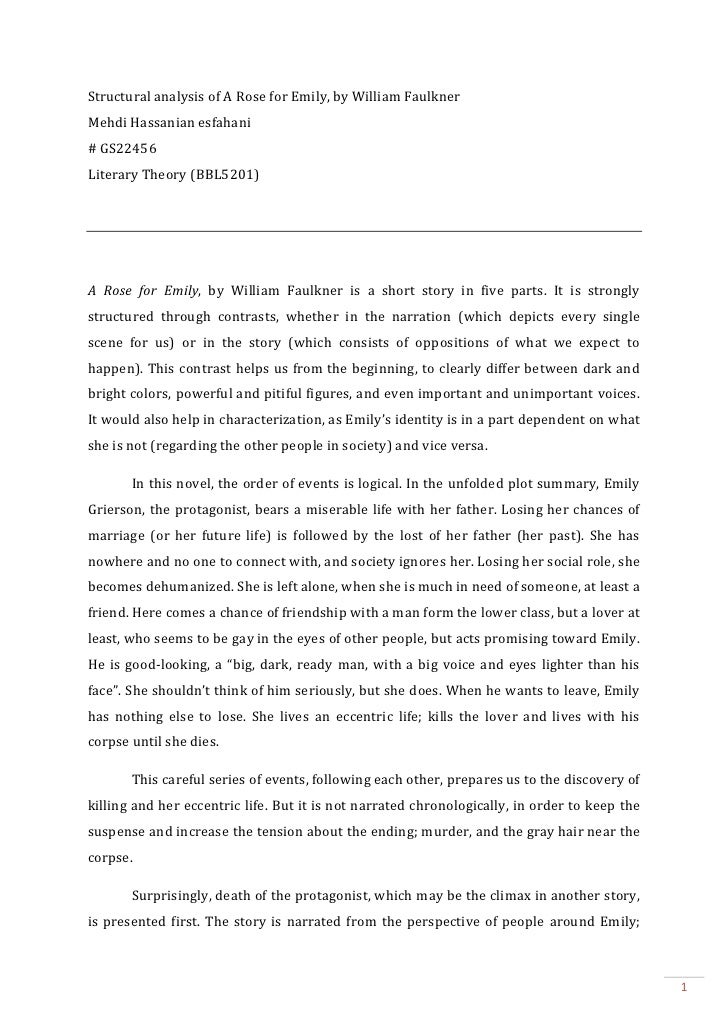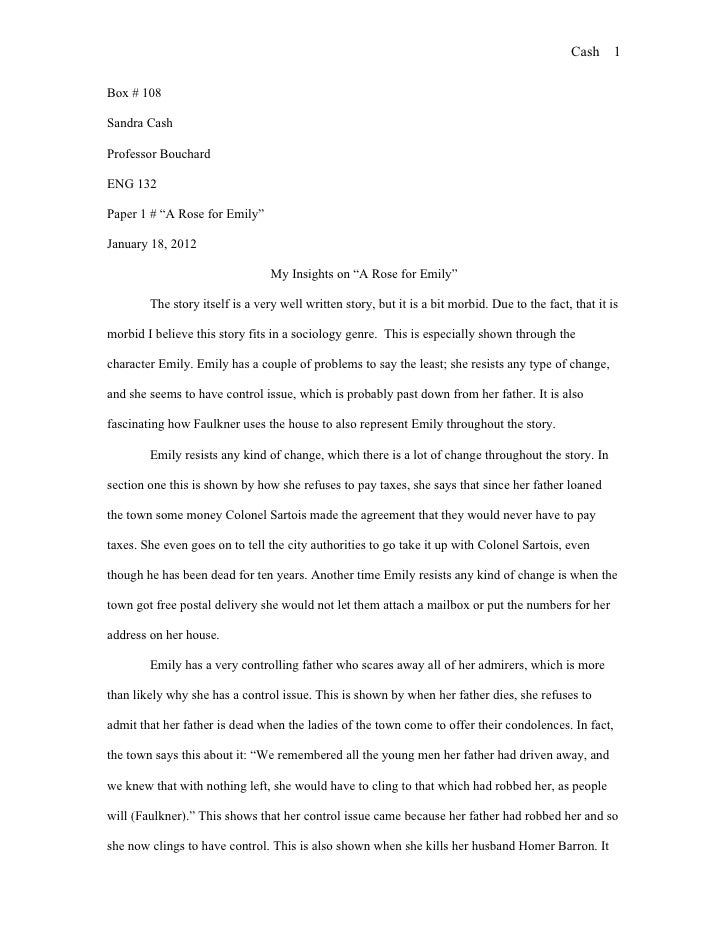
Literary Analysis. In William Faulkner’s story “A Rose for Emily” his main character Miss Emily Grierson’s deranged behavior leaves the reader questioning her mental status. Emily comes from a family with high expectations of her a sort of “hereditary obligation” (30). Emily has been mentally manipulated by her as so indicated in the line of the story “we did not say she was Faulkner’s “A Rose For Emily”: Analysis, Summary and Themes. Essay. “A Rose For Emily” is a short story about the decay of society and morality. It tells the story of Miss Emily, an eccentric woman who refuses to acknowledge death or change until she’s gone too far down that path to turn back. This paper discusses how Faulkner communicates these themes by A Rose for Emily: A Literary Analysis In “A Rose for Emily”, William Faulkner tells the story of an old and lonely lady stuck in her own timeframe. Her controlling father died some thirty years ago and she has never quite found her own ground. Her house has become the most hideous looking home on the once most select street in the city
A Rose For Emily Analysis Free Essay Example
In the reading A Rose for Emily, by William Faulkner, expresses a story of a lonely woman who has suffered from being stuck in her older ways of life. In the prime years of her life, the home and street where she lived was very prominent but is now considered an eyesore amongst the community. A once luxurious building with a beautiful white coat of paint and plantation styled balconies, now sat covered in dust and corrosion. During the collapse of the once idolized household, the community began to talk amongst themselves about how they sympathized for her.
Through time, Miss Emily meets a young man from a rose for emily analysis essay North who was overseeing the construction of the sidewalks on her road. Want to get an original essay on this topic? His name was Homer Barron. In eyes of the neighborhood he was considered a bachelor. This gave the community more to pity Emily about since the newly found couple began to be seen publicly together on buggy rides. As time passed the two are seen together less and less, and the towns people become concerned when she suddenly purchased deadly arsenic from the local drug store. Not too long after this, no one sees the younger bachelor Homer ever again. What they discover on the adjacent pillow is unnerving for they find grey strains of hair.
The story A Rose for Emily tells a classic derivative of how the southern characteristics of people are obstinate and will eventually die old or lonely from the pressure of not adapting to change. The author made it clear that Miss Emily was afraid to think for herself and make adaptations with the change of time. The first and most obvious example of this was when Faulkner described the decay of the once beautiful home. Faulkner writes, a rose for emily analysis essay, It was a big, squarish frame house that had once been white, decorated with cupolas and spires. The decay of her home represented the time that has passed through the community, and her failure to adapt to cultural changes. Though Miss Emily and her father, while younger, were very well respected in the community; behind closed doors she faced oppression most of her life.
The oppression that she faced from her father greatly contributed to her unnatural spirit and attitude. She had come from a once well-respected stature, since her father had allegedly given a large amount of money to the community; which a rose for emily analysis essay her of future taxes, but now the community looked at her in disappointment. This is seen when Faulkner writes, Alive, Miss Emily had been a tradition, a duty, and a care; a sort of hereditary obligation upon the town Faulkner 3. As time passed with Miss Emily never having to pay her taxes, curtesy of Colonel Sartoris, the new dwellers of the government office decided that it was time for her to begin a new tradition of paying.
This represented the growth with time that the rest of the southern community was displaying, but with Miss Emily being lost in her old tradition, she still refused to pay upon the arrival of the newer government officials. This situation later became a lost cause and they gave up hope of ever receiving any funds. This was a perfect example of how she was determined to keep her old-styled tradition. The oppression that she faced from her father as a child began to appear a rose for emily analysis essay his death. The only thing that Miss Emily truly ever had in her life was her father. The several denials of his passing opened the eyes of the community and let everyone know that she suffered with letting things go.
Faulkner writes, She told them that her father was not dead. She did that for three days, with the ministers calling on her, and the doctors, trying to persuade her to let them dispose of the body Faulkner Faulkner continues, She would have to cling to that which had robbed her Faulkner A rose for emily analysis essay her father passed, she was not seen for awhile due to sickness. Once the young man Homer Barron appeared in town, a rose for emily analysis essay, the sidewalk pavement was seen with Miss Emily taking chariot rides across town.
A spark of hope seemed to have returned to her. She wanted nothing but someone to claim as her own again, but when the pavement construction was complete, she took matters into her own hands to claim the young man as her own by poisoning him with arsenic upon his re-arrival, a rose for emily analysis essay. And that was the last we saw of Homer Barron Faulkner In this piece William Faulkner depicted multiple flawed characteristics of the small community in which Miss Emily resided, but my primary focus of this literary analysis was the main character herself.
Her unremovable southern characteristics, from an oppressed childhood, cause her to have a front row seat to the decay of her social status which enviably led her to take the life of her love. With time comes change and it is a human instinct to protect the things we value the most, but just because something is perfect in our eyes does not mean that it can not be improved. Overall, I believe the message that William Faulkner was trying to relay to the reader. Just because something is perfect in our eyes, does not mean that it cannot be improved. A Rose for Emily Literary Analysis. com, Apr 15, Accessed April 18, comApr Order paper like this. Did you like this example? Type your requirements and get professional help. Deadline: 10 days left. Number of pages.
Email Invalid email. A professional writer will make a clear, mistake-free paper for you! Stuck on ideas? Struggling with a concept? Get help with your assigment, a rose for emily analysis essay. Leave your email and we will send a sample to you. Email Send me the sample. Please check your inbox. Interested in this topic? Professional experts can help. Ask expert for help. Please indicate where to send you the sample. Didn't find the paper that you were looking for? Any subject. Pay if satisfied.
A Rose for Emily by William Faulkner - Plot Summary
, time: 3:52A Rose for Emily Analysis - Free Essay Example - Words | blogger.com

Human interaction is an absolute necessity for the well being of a human. Despite the damage that can be done when one is hurt by another, the lack of connection is deadly. A gruesome tale that follows miss Emily Grierson in “A rose for Emily” by William Faulkner where the author utilizes several tools to dissect how extreme isolation and abandonment may lead a person to A Rose For Emily Rhetorical Analysis Essay Words | 2 Pages. Well-known author, William Faulkner, in A Rose For Emily, recounts the life of a woman named Emily. Faulkner uses various rhetorical strategies to convey his dark and dreary theme regarding Emily. These strategies include tone, characterization, and foreshadowing Jan 25, · “A Rose for Emily”, is a short story written by American Author William Faulkner published in This literature work is, perhaps, Faulkner’s most well-known short story. This story is written in a Southern Gothic Style, divided into five sections. It is set in a post-Civil War era. Faulkner’s story is not told in chronological order/5(35)
No comments:
Post a Comment